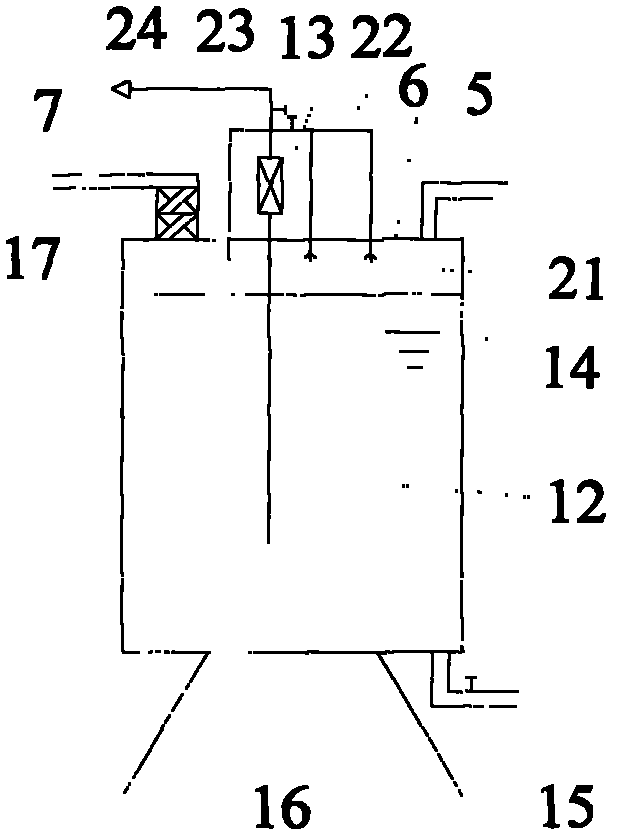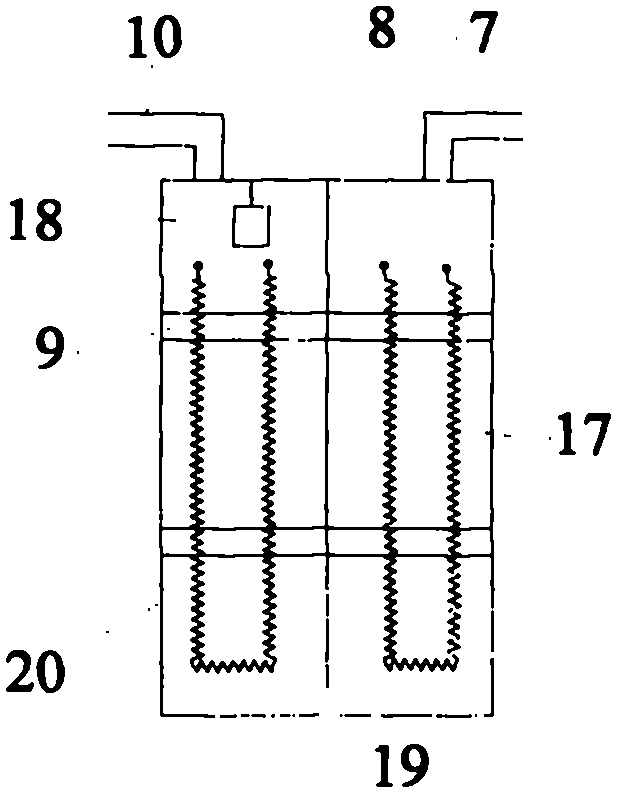Air purifier for clearing away harmful gases and dust for long tunneling working surface
A harmful gas, tunneling technology, applied in the construction of traffic tunnels, the construction of mine shafts without gas gushing, and the field of traffic engineering, it can solve the problems of high equipment damage rate, long ventilation time, large pressure loss, etc., to speed up the construction. progress, shortening ventilation time, and improving air quality
- Summary
- Abstract
- Description
- Claims
- Application Information
AI Technical Summary
Problems solved by technology
Method used
Image
Examples
Embodiment 1
[0032] 5 to 15 minutes after the blasting of the tunnel excavation face, at a distance of 20 to 50 minutes from the excavation face, the harmful gases CO, CO 2 , NO, NO 2 , sulfide, and dust are sent into the degradation tank by the fan, the pressure is 40kPa, and the air volume is 2300m 3 / h, the harmful gases CO and CO inhaled in the tunnel 2 , NO, NO 2 , sulfide, and dust are sent to the degradation pool, and are reacted or cleaned with alkaline compounds in the degradation pool, preferably the alkaline compound sodium carbonate, and CO, a small amount of NO, and water vapor that are difficult to react with alkaline compounds are filtered through a porous fiber separation membrane After steam. The CO and a small amount of NO filtered from the porous fiber separation membrane enter the low-temperature pressure swing adsorption tower with a temperature of 10-30°C for adsorption. The electric heating belt heats the adsorption tower to 80-135°C, preferably 100°C to desorb C...
Embodiment 2
[0034] 5 to 15 minutes after the blasting of the tunnel excavation face, at a distance of 20 to 50 minutes from the excavation face, the harmful gases CO, CO 2 , NO, NO 2 , sulfide, and dust are sent to the degradation tank by the fan, the pressure is 30kPa, the pressure is 3kPa, and the air volume is 2700m 3 / h, the harmful gases CO and CO inhaled in the tunnel 2 , NO, NO 2 , sulfide, and dust are sent to the degradation pool, and are reacted or cleaned with alkaline compounds in the degradation pool, preferably the alkaline compound sodium carbonate, and CO, a small amount of NO, and water vapor that are difficult to react with alkaline compounds are filtered through a porous fiber separation membrane After steam. The CO and a small amount of NO filtered from the porous fiber separation membrane, with a pressure of 3kPa, enter the low-temperature pressure swing adsorption tower with a temperature of 10-30°C for adsorption. CO and a small amount of NO are adsorbed in the a...
Embodiment 3
[0036] 5 to 15 minutes after the blasting of the tunnel excavation face, at a distance of 20 to 50 minutes from the excavation face, the harmful gases CO, CO 2 , NO, NO 2 , sulfide, and dust are sent to the degradation tank by the fan, the pressure is 40kPa, the pressure is 2kPa, and the temperature is 2900m 3 / h, the harmful gases CO and CO inhaled in the tunnel 2 , NO, NO 2 , sulfide, and dust are sent to the degradation pool, and are reacted or cleaned with alkaline compounds in the degradation pool, preferably the alkaline compound sodium carbonate, and CO, a small amount of NO, and water vapor that are difficult to react with alkaline compounds are filtered through a porous fiber separation membrane After steam. The CO and a small amount of NO filtered through the porous fiber separation membrane enter the low-temperature pressure swing adsorption tower with a temperature of 10-30°C for adsorption at a pressure of 2kPa. CO and a small amount of NO are adsorbed in the a...
PUM
 Login to View More
Login to View More Abstract
Description
Claims
Application Information
 Login to View More
Login to View More - R&D
- Intellectual Property
- Life Sciences
- Materials
- Tech Scout
- Unparalleled Data Quality
- Higher Quality Content
- 60% Fewer Hallucinations
Browse by: Latest US Patents, China's latest patents, Technical Efficacy Thesaurus, Application Domain, Technology Topic, Popular Technical Reports.
© 2025 PatSnap. All rights reserved.Legal|Privacy policy|Modern Slavery Act Transparency Statement|Sitemap|About US| Contact US: help@patsnap.com



